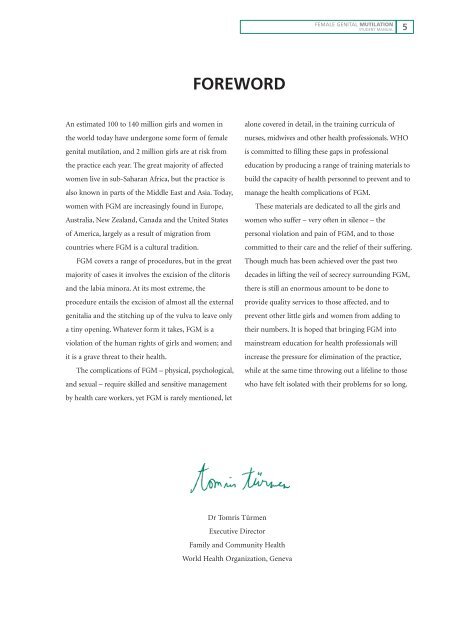Female Genital Mutilation - World Health Organization
Female Genital Mutilation - World Health Organization
Female Genital Mutilation - World Health Organization
Create successful ePaper yourself
Turn your PDF publications into a flip-book with our unique Google optimized e-Paper software.
An estimated 100 to 140 million girls and women in<br />
the world today have undergone some form of female<br />
genital mutilation, and 2 million girls are at risk from<br />
the practice each year. The great majority of affected<br />
women live in sub-Saharan Africa, but the practice is<br />
also known in parts of the Middle East and Asia. Today,<br />
women with FGM are increasingly found in Europe,<br />
Australia, New Zealand, Canada and the United States<br />
of America, largely as a result of migration from<br />
countries where FGM is a cultural tradition.<br />
FGM covers a range of procedures, but in the great<br />
majority of cases it involves the excision of the clitoris<br />
and the labia minora. At its most extreme, the<br />
procedure entails the excision of almost all the external<br />
genitalia and the stitching up of the vulva to leave only<br />
a tiny opening. Whatever form it takes, FGM is a<br />
violation of the human rights of girls and women; and<br />
it is a grave threat to their health.<br />
The complications of FGM – physical, psychological,<br />
and sexual – require skilled and sensitive management<br />
by health care workers, yet FGM is rarely mentioned, let<br />
FOREWORD<br />
Dr Tomris Türmen<br />
Executive Director<br />
Family and Community <strong>Health</strong><br />
<strong>World</strong> <strong>Health</strong> <strong>Organization</strong>, Geneva<br />
FEMALE GENITAL MUTILATION<br />
STUDENT MANUAL<br />
alone covered in detail, in the training curricula of<br />
nurses, midwives and other health professionals. WHO<br />
is committed to filling these gaps in professional<br />
education by producing a range of training materials to<br />
build the capacity of health personnel to prevent and to<br />
manage the health complications of FGM.<br />
These materials are dedicated to all the girls and<br />
women who suffer – very often in silence – the<br />
personal violation and pain of FGM, and to those<br />
committed to their care and the relief of their suffering.<br />
Though much has been achieved over the past two<br />
decades in lifting the veil of secrecy surrounding FGM,<br />
there is still an enormous amount to be done to<br />
provide quality services to those affected, and to<br />
prevent other little girls and women from adding to<br />
their numbers. It is hoped that bringing FGM into<br />
mainstream education for health professionals will<br />
increase the pressure for elimination of the practice,<br />
while at the same time throwing out a lifeline to those<br />
who have felt isolated with their problems for so long.<br />
5

















